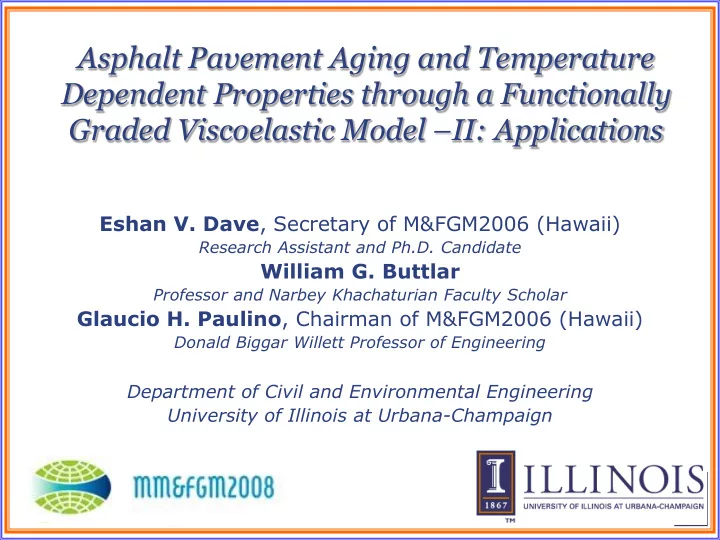

Asphalt Pavement Aging and Temperature Dependent Properties through a Functionally Graded Viscoelastic Model – II: Applications Eshan V. Dave , Secretary of M&FGM2006 (Hawaii) Research Assistant and Ph.D. Candidate William G. Buttlar Professor and Narbey Khachaturian Faculty Scholar Glaucio H. Paulino , Chairman of M&FGM2006 (Hawaii) Donald Biggar Willett Professor of Engineering Department of Civil and Environmental Engineering University of Illinois at Urbana-Champaign
Outline Part – I – Graded Finite Elements – Viscoelasticity and FGMs – Finite Element Formulations – Verification – Concluding Remarks Part – II – Asphalt Pavements – Effect of Aging – Simulations – Concluding Remarks 2
Objectives Develop efficient and accurate simulation scheme for viscoelastic functionally graded materials (VFGMs) Correspondence Principle based formulation Application: Asphalt concrete pavements (Part II) 3
Asphalt Concrete Constituents: – Asphalt Binder – Aggregates Asphalt Binder: – Derived from Crude Oil – Many times modified with polymers to enhance properties – Undergoes oxidative aging (stiffening) with time Asphalt Concrete (Asphalt Mixture) – Large fraction produced as hot-mix asphalt (HMA) – Most common form of pavement surfacing material (96% of pavement surface in United States) 4
Pavements are GRADED Structures Sources: 1. Oxidative aging 2. Temperature dependence of material properties 3. Other sources (construction, additives etc.) Complex Modulus, (GPa) Temperature (C) Complex Modulus, E* (GPa) Temperature (C) -15 -10 -5 0 5 0 5 10 15 20 0 0 Depth from Surface (mm) 10 50 Depth from Surface (mm) 20 100 Depth (mm) 30 150 9:00 AM Pavement Age=15years 40 200 3:00 PM 6:00 PM 50 250 9:00 PM 60 300 12:00 AM 3:00 AM 70 350 80 400 Aging gradient generated using “Global Temperature profiles generated using aging model” by Mirza and Witczak “EICM” from AASHTO MEPDG 5
Asphalt Concrete is time-dependent (Viscoelastic) Asphalt mixtures from US36 E 2 E N E 1 τ 1 τ 2 τ N Temperature = -20C 6
Pavement Section Simulation model based on Interstate highway located in Lincoln, Illinois (I-155) Full depth asphalt concrete pavement Surface Course, 38.1-mm Long-term aged Asphalt Base Course, 337-mm Concrete Short-term aged Lime Treated Clay Stabilized Subgrade, 304-mm (E = 138-MPa) Clay Natural Subgrade (E = 35-MPa) 7
Effect of Aging on Material Response Data from Apeagyei et al. (2008) 8
FE Model Two-dimensional axi-symmetric conditions Single Tire load simulated (up to 1000-sec loading time) Two mesh refinement levels Coarse mesh: Graded and Homogeneous simulations Fine Mesh: Layered simulations Surface Course Base Course Stabilized Subgrade z Subgrade X 9
FEM Discretization Coarse Mesh Fine Mesh 6 Layers 16 Layers 129060 DOFs 72150 DOFs 10
Simulation Results Material Distributions: FGM Aged Layered Unaged Pavement Responses: Tensile strain at bottom of asphalt layer (to investigate cracking and fatigue) Shear strain at wheel edge (longitudinal cracking/rutting) Comparison of FGM and Layered predictions Compressive strain at interface of asphalt layers 11
Simulation Results: Strain at Bottom of AC AC Soil 12
Simulation Results: Strain at Tire Edge AC Soil 13
Simulation Results: FGM vs. Layered ~ 20% Jump Surface Course Base Course Stabilized Subgrade 14
Concluding Remarks Consideration aging effect is important for obtaining reliable response of asphalt pavements Viscoelastic FGM analysis procedure developed herein provides an accurate and efficient way of analyzing asphalt pavements Layered approach may provide results with significant errors at the layer interfaces (especially stresses) Most severe response observed for this limited study was the shear strains at the edge of tire load. 15
Applications of Current and Proposed Research Simulation of Transition Layers AC PCC Subgrade Applications Analysis of Graded Polymers, for example: • Effects of UV radiation on Design of Viscoelastic FGMs polymer coatings • Aerospace and automobile applications E ( x , t ) E [ ax bExp [ y ], t ] 16
Thank you for your attention!! 17
Thank you for your attention!! E 2 E N E 1 z τ 1 τ 2 τ N y x 18
Recommend
More recommend